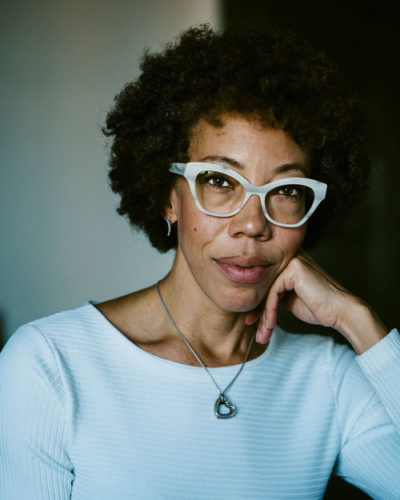Of Figurative Painting and a First Lady
Share
Explore Our Galleries
Breaking News!
Today's news and culture by Black and other reporters in the Black and mainstream media.
Ways to Support ABHM?
By Kelundra Smith, The Bitter Southerner

Amy Sherald. photo by Justin T. Gellerson
Watching Amy Sherald step onstage at Spelman College, her pink-framed glasses screaming fun and her blonde afro perfectly coiffed, it’s hard to believe that there were times in her life when she almost wasn’t an artist. As a freshman at Clark Atlanta University, she was pre-med and later a heart condition nearly dulled her wash. However, as she settled into a high-back chair, smoothing out her multi-colored striped dress and crossing her legs to reveal a pair of crisp white and rose gold sneakers, it was clear that a master was in the room. With an auditorium full of art students and fans hanging onto her every word, she seemed right at home.
Sherald was born in Columbus, Georgia in 1973 when as she describes it “there was still residual racism.” Her father was a dentist, and her mother was an educator, and they intended for their children to become doctors, lawyers accountants—anything but an artist. So, when she moved to Atlanta and started her freshman year at Clark, she was ready to follow the charted path. But, an encounter with a street artist in downtown Atlanta changed everything. She told the man that she was an artist and showed him one of her drawings. He told her that if she didn’t use her talent, she would lose it, and that was all the impetus she needed to start taking art classes at Spelman.
She found her niche in figurative painting, a genre that called to her because of the absence of black faces. Romanticized images of white aristocrats dominate most museums’ portrait collection, and Sherald has made it her mission to expand the art historical narrative by painting black people from all walks of life.

Sherald’s portrait of former first lady Michelle Obama
Most notably, she was selected to paint Michelle Obama for the National Portrait Gallery, and her representation of the former first lady drew a range of ridicule and praise. Those unfamiliar with her signature use of gray to represent black and brown skin were puzzled by the choice, but those familiar with her genius knew she was right on point…
Read full article here
More Breaking News here
View more ABHM galleries here









Comments Are Welcome
Note: We moderate submissions in order to create a space for meaningful dialogue, a space where museum visitors – adults and youth –– can exchange informed, thoughtful, and relevant comments that add value to our exhibits.
Racial slurs, personal attacks, obscenity, profanity, and SHOUTING do not meet the above standard. Such comments are posted in the exhibit Hateful Speech. Commercial promotions, impersonations, and incoherent comments likewise fail to meet our goals, so will not be posted. Submissions longer than 120 words will be shortened.
See our full Comments Policy here.